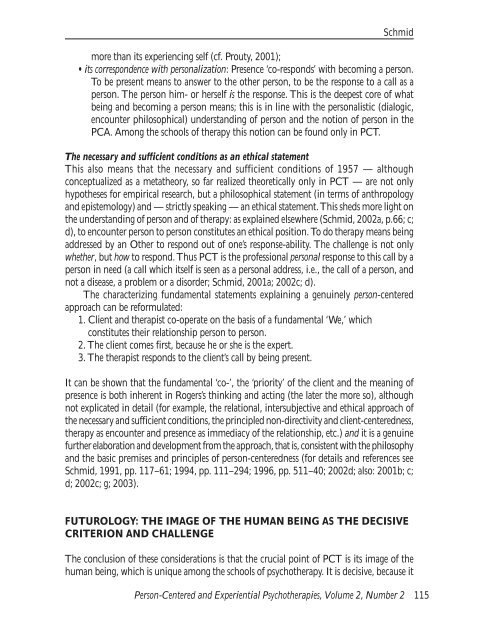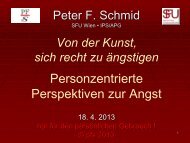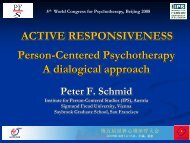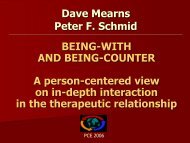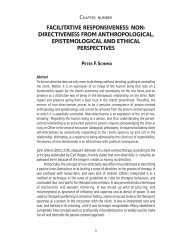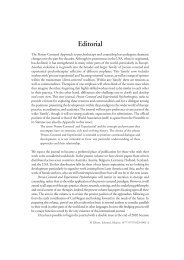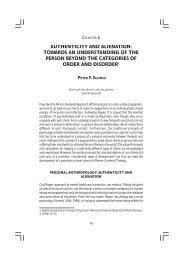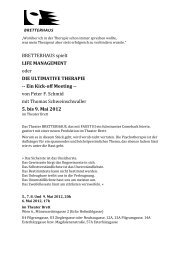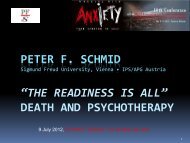The Characteristics of a Person-Centered ... - Peter F. Schmid
The Characteristics of a Person-Centered ... - Peter F. Schmid
The Characteristics of a Person-Centered ... - Peter F. Schmid
- No tags were found...
Create successful ePaper yourself
Turn your PDF publications into a flip-book with our unique Google optimized e-Paper software.
<strong>Schmid</strong>more than its experiencing self (cf. Prouty, 2001);• its correspondence with personalization: Presence ‘co-responds’ with becoming a person.To be present means to answer to the other person, to be the response to a call as aperson. <strong>The</strong> person him- or herself is the response. This is the deepest core <strong>of</strong> whatbeing and becoming a person means; this is in line with the personalistic (dialogic,encounter philosophical) understanding <strong>of</strong> person and the notion <strong>of</strong> person in thePCA. Among the schools <strong>of</strong> therapy this notion can be found only in PCT.<strong>The</strong> necessary and sufficient conditions as an ethical statementThis also means that the necessary and sufficient conditions <strong>of</strong> 1957 — althoughconceptualized as a metatheory, so far realized theoretically only in PCT — are not onlyhypotheses for empirical research, but a philosophical statement (in terms <strong>of</strong> anthropologyand epistemology) and — strictly speaking — an ethical statement. This sheds more light onthe understanding <strong>of</strong> person and <strong>of</strong> therapy: as explained elsewhere (<strong>Schmid</strong>, 2002a, p.66; c;d), to encounter person to person constitutes an ethical position. To do therapy means beingaddressed by an Other to respond out <strong>of</strong> one’s response-ability. <strong>The</strong> challenge is not onlywhether, but how to respond. Thus PCT is the pr<strong>of</strong>essional personal response to this call by aperson in need (a call which itself is seen as a personal address, i.e., the call <strong>of</strong> a person, andnot a disease, a problem or a disorder; <strong>Schmid</strong>, 2001a; 2002c; d).<strong>The</strong> characterizing fundamental statements explaining a genuinely person-centeredapproach can be reformulated:1. Client and therapist co-operate on the basis <strong>of</strong> a fundamental ‘We,’ whichconstitutes their relationship person to person.2. <strong>The</strong> client comes first, because he or she is the expert.3. <strong>The</strong> therapist responds to the client’s call by being present.It can be shown that the fundamental ‘co-’, the ‘priority’ <strong>of</strong> the client and the meaning <strong>of</strong>presence is both inherent in Rogers’s thinking and acting (the later the more so), althoughnot explicated in detail (for example, the relational, intersubjective and ethical approach <strong>of</strong>the necessary and sufficient conditions, the principled non-directivity and client-centeredness,therapy as encounter and presence as immediacy <strong>of</strong> the relationship, etc.) and it is a genuinefurther elaboration and development from the approach, that is, consistent with the philosophyand the basic premises and principles <strong>of</strong> person-centeredness (for details and references see<strong>Schmid</strong>, 1991, pp. 117–61; 1994, pp. 111–294; 1996, pp. 511–40; 2002d; also: 2001b; c;d; 2002c; g; 2003).FUTUROLOGY: THE IMAGE OF THE HUMAN BEING AS THE DECISIVECRITERION AND CHALLENGE<strong>The</strong> conclusion <strong>of</strong> these considerations is that the crucial point <strong>of</strong> PCT is its image <strong>of</strong> thehuman being, which is unique among the schools <strong>of</strong> psychotherapy. It is decisive, because it<strong>Person</strong>-<strong>Centered</strong> and Experiential Psychotherapies, Volume 2, Number 2 115


